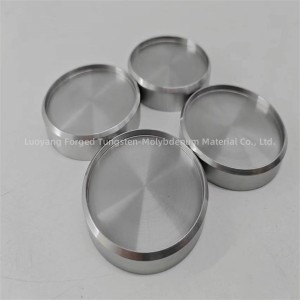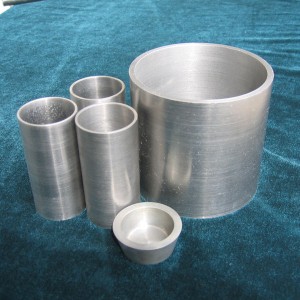High density 99.95% Hafnium round rod
Hafnium rod is a high-purity hafnium metal rod composed of hafnium and other elements, characterized by plasticity, ease of processing, high temperature resistance, and corrosion resistance. The main component of hafnium rod is hafnium, which can be divided into circular hafnium rod, rectangular hafnium rod, square hafnium rod, hexagonal hafnium rod, etc. according to the different cross-sectional shapes. The purity range of hafnium rods is from 99% to 99.95%, with a cross-sectional size of 1-350mm, a length of 30-6000mm, and a minimum order quantity of 1kg.
| Dimensions | As your requirement |
| Place of Origin | Henan, Luoyang |
| Brand Name | FGD |
| Application | Nuclear industry |
| Shape | Round |
| Surface | Polished |
| Purity | 99.9% Min |
| Material | hafnium |
| Density | 13.31 g/cm3 |

|
classification |
Nuclear industry |
General industrial |
|
|
Brand |
Hf-01 |
Hf-1 |
|
|
Main components |
Hf |
margin |
margin |
|
impurity≤ |
Al |
0.010 |
0.050 |
|
C |
0.015 |
0.025 |
|
|
Cr |
0.010 |
0.050 |
|
|
Cu |
0.010 |
- |
|
|
H |
0.0025 |
0.0050 |
|
|
Fe |
0.050 |
0.0750 |
|
|
Mo |
0.0020 |
- |
|
|
Ni |
0.0050 |
- |
|
|
Nb |
0.010 |
- |
|
|
N |
0.010 |
0.0150 |
|
|
O |
0.040 |
0.130 |
|
|
Si |
0.010 |
0.050 |
|
|
W |
0.020 |
- |
|
|
Sn |
0.0050 |
- |
|
|
Ti |
0.010 |
0.050 |
|
|
Ta |
0.0150 |
0.0150 |
|
|
U |
0.0010 |
- |
|
|
V |
0.0050 |
- |
|
|
Zr |
3.5 |
3.5 |
|
|
The Zr content can also be communicated between both parties |
|||
|
Diameter |
Allowable deviation |
|
≤4.8mm |
±0.05mm |
|
>4.8-16mm |
±0.08mm |
|
>16-19mm |
±0.10mm |
|
>19-25mm |
±0.13mm |
|
Diameter |
Allowable deviation |
||
|
|
<1000 |
1000-4000 |
>4000 |
|
≤9.5 |
+6.0 |
+13.0 |
+19.0 |
|
9.5-25 |
+6.0 |
+9.0 |
— |
1. Our factory is located in Luoyang City, Henan Province. Luoyang is a production area for tungsten and molybdenum mines, so we have absolute advantages in quality and price;
2. Our company has technical personnel with over 15 years of experience, and we provide targeted solutions and suggestions for each customer's needs.
3. All of our products undergo strict quality inspection before being exported.
4. If you receive defective goods, you can contact us for a refund.

1. Raw material preparation
2. Electrolytic production
3. Thermal decomposition method
4. Chemical vapor deposition
5. Separation technology
6. Refining and Purification
7. Quality testing
8. Packing
9.Shipping
1. Nuclear Reactor
Control Rods: Hafnium rods are commonly used as control rods in nuclear reactors. Their high neutron absorption capacity enables them to effectively regulate the fission process, ensuring safe and controlled nuclear reactions.
2. Aerospace and Defense
High Temperature Alloys: Due to its high melting point and strength, hafnium is used in aerospace applications, including the production of high temperature alloys and coatings for jet engines and other components exposed to extreme conditions.
3. Electronic Products
Semiconductors: Hafnium is used in the semiconductor industry, particularly in the production of high-k dielectrics for transistors. This helps improve the performance and efficiency of electronic devices.
4. Research and Development
Experimental Applications: Hafnium rods can be used in various experimental devices for materials science and nuclear physics research, and their unique properties can be used for innovative research.
5. Medical Applications
Radiation Shielding: In certain medical applications, hafnium is used for radiation shielding due to its neutron absorption properties.







Hafnium is used in control rods for several key reasons:
1. Neutron Absorption
Hafnium has a high neutron capture cross section, which means it is very efficient at absorbing neutrons. This property is crucial for controlling the rate of nuclear fission in a reactor.
2. Stability at high temperatures
Hafnium maintains its structural integrity and performance at the high temperatures common in nuclear reactors, making it a reliable choice for control rods.
3. Corrosion Resistance
Hafnium has excellent corrosion resistance, which is very important in the harsh chemical environment of nuclear reactors. This helps ensure the longevity and effectiveness of the control rods.
4. Low reactivity
Hafnium is relatively inert, minimizing the risk of adverse chemical reactions that could compromise reactor safety.
Hafnium is not radioactive. It is a stable element and does not contain isotopes considered radioactive. The most common isotope of hafnium is hafnium-178, which is stable and does not undergo radioactive decay.












